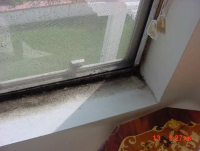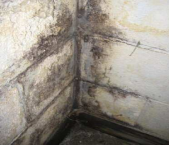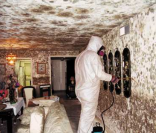Mould and dampness
- To reduce the risk of mould growth, as well as the release of other pollutants, excess moisture indoors should be avoided.
- Any mould or dampness could be a health risk and should be removed as soon as it is observed.
- Scrubbing is the most important component of mould removal it physically removes mould spores and prevents regrowth.
Mould and dampness in homes may cause health problems.
Indoor mould and dampness can also cause unpleasant odours and damage to building materials, contents and structures, which can lead to expensive maintenance or management costs.
What are the health effects of mould?

Mould and dampness indoors have been associated with health problems such as:
Reactions are more likely to occur in people with serious allergies to mould and those with chronic lung disease. However, even people without known mould allergies may experience some health problems.
If you have persistent health problems that may be mould-related, visit your GP.
Is some mould more toxic than others? Should I have it tested?
Any mould or damp indoors may cause health problems and symptoms do not seem to be related to one specific type of mould.
Mould sampling is not necessary to determine the health risk. Any mould or dampness problems should be considered a potential health risk and should be remediated as soon as possible
Where will mould grow?
Mould is a fungal growth that can grow in homes when conditions are damp, dark and poorly ventilated.
Common places for mould growth include:
- bathrooms
- kitchens
- cluttered storage areas
- wall and roof spaces
- behind furniture.
What is hidden mould?
Mould or damp patches are not always visible and you may have hidden mould or damp. This may exist if:
- there is a mouldy/earthy odour
- there is regular condensation indoors
- the home feels regularly humid.
Places where you may find hidden mould or damp include:
- opposite side of dry walls, wallpaper or panelling
- roof materials above ceiling tiles (due to leaks or insufficient insulation) – cement roof tiles may lose their outer glaze and absorb moisture into roof spaces
- underside of carpets and pads, or curtains
- inside walls, particularly around pipes that are leaking or condensing and drains
- in roof spaces, particularly if moist air is vented into the roof space but not allowed to escape
- condensate drain pans inside air handling units
- porous thermal or acoustic liners inside ductwork
- insulation.
You may need professional help to find and remove hidden mould.
What about excess moisture and mould?

The key component for mould growth is excess moisture. Moisture can come from outdoors or be generated indoors.
Common sources of moisture include:
- surface water leaking into the building
- wet building foundations (eg. rising damp)
- rain leaking in through the roof or walls
- poor ventilation
- showering, cooking and boiling without adequate ventilation (exhaust fans/open windows)
- use of clothes dryers and unflued gas heaters without adequate ventilation
- indoor plumbing leaks
- indoor liquid spills
- storing large amounts of water absorbent materials, such as books or cardboard boxes, in a damp space.
How do I get rid of mould and damp?
Most mould can be treated by following these steps:
- Scrub mould off hard surfaces using soapy water. The physical action of scrubbing is the most important component as all the mould must be physically removed to prevent regrowth. Make sure you scrub up to 50cm from the edge of the visible mould as there may be new growth that is not visible to the naked eye.
- Clean up any mould residue caused by the scrubbing. Use a damp cloth or vacuum cleaner with a HEPA filter.
- Dry the area.
- Find and fix the source of the moisture.
When removing mould, make sure:
- you wear personal protective equipment (rubber gloves, face mask and safety goggles)
- the room is well ventilated – but that there isn’t a lot of air movement that will blow the spores into other areas of the home.
Soapy water is usually sufficient for removing mould. Other products that can be used include:
- commercially available products
- natural anti-fungal agents such as vinegar, tea-tree oil.
Remember, fungicides that are developed for outdoor use should not be used for indoor mould.
Do I need professional help?

If the problem is large, recurring or can’t be found (hidden mould) professional help may be required.
Different professionals may be required for identifying and cleaning the mould and for fixing the underlying problem. For example:
- indoor environment experts or mould specialists may be required to evaluate and remediate mould problems
- plumbers may be needed to identify and fix plumbing leaks
- builders or roof specialists will be required to fix leaks in the building structure
- air-conditioning consultants/engineers may be needed for identifying problems with the air conditioning system.
Before engaging a professional to remove mould, check their experience and track record.
I am renting and there is mould in the building. What should I do?
Mould and damp caused by structural faults or leaks should be remedied by the owner.
However, you must ensure that you are not generating too much moisture indoors and that the building is adequately ventilated.
If you have taken measures to ensure the building is properly heated and aired and mould is still growing, you should raise the issue with the owner or property agent.
If you are seeking further advice, please contact:
Tenancy WA:
- Metro Advice Hotline 9221 0088
- Country Advice Hotline 1800 621 888
- Consumer Protection 1300 304 054.
More information
If you want more detailed information on mould identification and removal you can download the guidelines for managing mould and dampness (PDF 5.2MB).
Contact Environmental Health Services at your local government (external site).
Acknowledgements
Public Health
This publication is provided for education and information purposes only. It is not a substitute for professional advice. Information about a service, product or treatment does not imply endorsement and is not intended to replace professional advice. Readers should note that over time currency and completeness of the information may change. All users should seek advice from a qualified professional for answers to their questions.